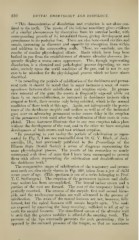Page 640 - My FlipBook
P. 640
650 DENTAL EMBRYOLOGY AND HISTOLOGY.
" This demonstration of dissolution and evolution is not alone con-
fined to the teeth. The ramus of the inferior maxillary gives evidence
of a similar phenomenon by absorption from its anterior border, with
corresponding growth of its interstitial tissue, giving development and
prominence to its posterior line. There are also bone-cased cavities and
canals, increasing in diameter and capacity by absorption from within
and addition to the surrounding walls. These, we conclude, are the
results of similar physiological efforts. Roots which have long been
bathed in pus from the establishment of chronic alveolar abscesses fre-
quently display a worm-eaten appearance. This, though representing
dissolution, is a chemical and pathological process depending, we sur-
mise, entirely upon the acrid condition of the pus, and is not in any
case to be mistaken for the physiological process which we have above
described.
" In recording the periods of calcification of the deciduous and perma-
nent teeth it should be noted that in many instances a want of corre-
spondence between their calcification and eruption exists. By jjrema-
ture removal of the gum the crown is frequently exposed while yet
there is no root-calcification, as instanced in deciduous incisors when
erupted at birth, their crowns only being calcified, which is the normal
condition of these teeth at this age. Again, not infrequently the persis-
tence of the deciduous cuspids and molars as well as of the indurated
gum over an advancing permanent molar causes delay in the eruption
of the permanent teeth until after the calcification of their roots is com-
pleted. These instances illustrate that in one case eruption takes place
without the development of the root, and in the other we have complete
develo])ment of both crown and root without eruption.
" In presenting to you to-day the periods of calcification as repre-
sented by Fig. 2, I am not unmindful that Dr. G. V. Black, of Jack-
sonville, 111., had previously published in the Proceedings of the
Illinois State Dental Society a series of diagrams representing the
same physiological process. The results of his researches so nearly
correspond with those of mine that I have been encouraged to present
them with others representing the calcification and decalcification of
the deciduous teeth."
The comparative stages of calcification of the temporary and perma-
nent teeth are also nicely shown in Fig. 368, taken from a jaw of child
seven years of age. (This specimen is one of a series belonging to Prof.
T. C. Stellwagcn.) The eruption of the permanent incisors and sixth-
year molars has been accomjilished. The lateral incisor crown and a
portion of the root are formed. The root of the temporary lateral is
partially resorbed. The ci'OAvns of the cuspids, first and second bicus-
pids, and the twelve-year molars are well advanced in the process of
calcification. The roots of the central incisors are not, however, fully
formed, but the apical foramen still remain largely open. The roots
are exposed l)y removing the bony covering ; sufficient is left at mf to
mark the mental foramen. The cancellated nature of the alveolar wall
is such that the greatest mobility is afforded the erupting tooth. The
pressure of the li})s externally prevents the arch protruding ; tliis is
opposed by the outward pressure of the tongue, so that no uneasiness


